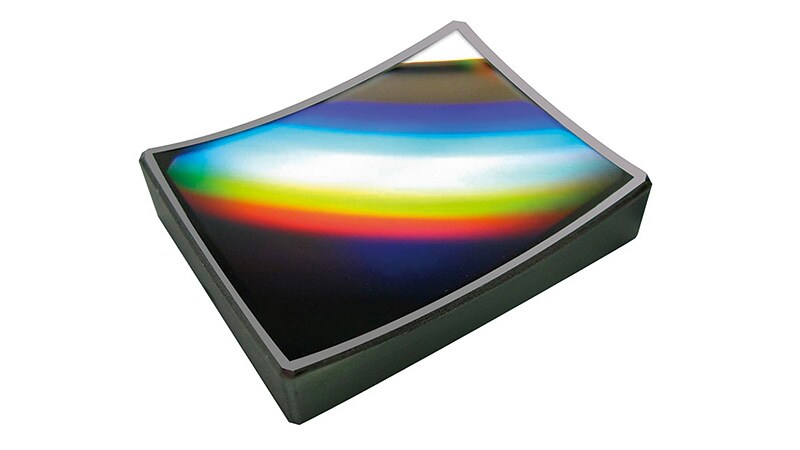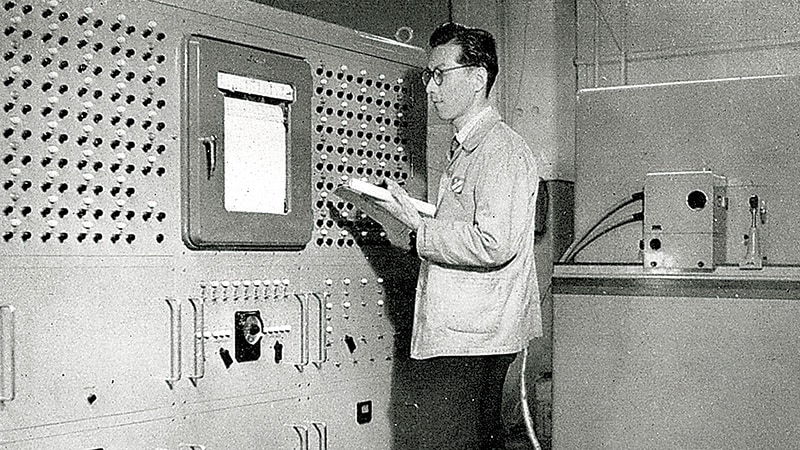Beautiful Optical Elements Analyze All Kinds of Light and Support the Development of Industry
Series: Shimadzu's Heritage
Beautiful diffraction gratings shine in a rainbow of colors.
Embedded into the hearts of countless products, they play an essential role in industrial development.
Analyzing Light Gives a Detailed View of Distant Stars
Sparkling stars in the night sky.
In the past, humankind classified stars using only adjectives such as “bright” or “dark,” and “red” or “blue.” Today, however, we also know their positions, velocity, compositions, density, and pressure. This was revealed using a technique called “spectroscopy.”
Spectroscopy is used to determine what is contained in a target substance, without destroying or touching it, by shining arbitrary wavelengths of light on that substance. In addition to investigating a substance’s composition, spectroscopy can also be used to determine its concentration, refractive index, crystallinity, and other properties, and has become an indispensable technique in many different industries, including material engineering, petrochemicals, chemical manufacturing, steel, automobiles, and semiconductor manufacturing.
Wavelengths of light are easy to understand if we consider the prism experiment. While the visible light that can be detected by the human eye is called “white light,” when passed through a prism, such light is decomposed into various colors resembling a rainbow.
The differences between these colors of light are the differences in their wavelengths. In other words, white light is actually a collection of light of various colors. In fact, different substances reflect and absorb completely different wavelengths of light. Apples appear red because they absorb green light, while reflecting light with green’s complementary color, red, back to the eyes.
A spectrophotometer measures a sample placed several centimeters away from a light source inside the instrument. This is the same principle used in spectroscopic observation to examine the light from stars hundreds of millions of light years away. This technique tells us what distant stars are made of, as well as how quickly they are moving away from the Earth or how fast they are rotating.
Over the past few years, spectroscopic observation has grown so accurate that we can also investigate the compositions of planets revolving around distant stars, and by checking for characteristics like the presence of water, scientists are actively searching for planets that can support life.
Diffraction Gratings Also Support Invisible Light
The key to spectroscopy is decomposing light. In the past, the device used for this purpose was the prism.
In 1952, Shimadzu released its first UV-VIS spectrophotometer, the QB-50. This spectrophotometer was equipped with a prism. However, the rapid development of industry created a need for spectroscopy at a more accurate and detailed level. Sentiments regarding the limitations of prisms, which could hardly be said to have excellent decomposition accuracy, began to emerge.
At this time, the diffraction grating began gaining attention. Unlike prisms, diffraction gratings not only support visible light, but also wavelengths such as ultraviolet, X-ray, and infrared. In addition to greatly expanding the potential applications of spectroscopy, they also have a higher decomposition accuracy, making the diffraction grating an essential device as manufacturing grew more sophisticated.
The diffraction grating itself is an optical element consisting of a plate of glass or other material upon which narrow grooves (slits) spaced roughly a micrometer apart are arranged in a regular manner, causing a phenomenon called diffraction to occur. Diffraction is a phenomenon in which “waves” wrap behind or around obstacles. For instance, the way that waves slip through the gaps in a breakwater is one form of diffraction. Also, when sounds from outside bend around corners, and can be heard even from inside a building with thick concrete walls, that is also caused by diffraction.

Toroidal diffraction grating
Like water and sound, light also possesses the properties of a wave. When white light passes through a diffraction grating, specific wavelengths of light bend at the same angle in an attempt to avoid the obstacles (slits). Through overlapping and reinforcement, bands of light of the same wavelength—in other words, the same colors—are clearly drawn on the far side of the diffraction grating.
Shimadzu’s history as a manufacturer of diffraction gratings dates back to the 1950s. Although diffraction gratings were a rare product at the time, Shimadzu imported them from the US-based company, Bausch & Lomb, with which it had a technical partnership, while also learning the technologies necessary to manufacture diffraction gratings themselves.
In 1975, Shimadzu conducted joint research aimed at commercialization based on the technology developed by RIKEN, which had obtained a patent on diffraction gratings. Shimadzu pursued advanced research while learning the basic technology from RIKEN. In doing so, Shimadzu accumulated technology for processing diffraction gratings. At the same time, Shimadzu improved the performance of its diffraction gratings and obtained a joint patent. The Japanese spectroscopy market was growing at that time, and the acquisition of technology for manufacturing diffraction gratings was the driving force for a series of home-grown spectroscopic devices that Shimadzu launched.

Direct-reading photoelectric spectroscopic analyzer
Diffraction gratings are used in spectroscopic devices such as the one shown in this photograph. This device is used to analyze alloys as a means of quality control in the metal industry. The components and amounts of the spectroscopically analyzed alloy are recorded immediately via photoelectric measurement. From “40th Anniversary of the Reorganization Commemorative Journal,” 1957.
Applications Continue to Grow, from Medicine to Semiconductors and Food
Currently, Shimadzu diffraction gratings are used in its own spectrophotometers and in the products of various other companies.
Diffraction gratings are embedded in devices such as spectrophotometers that analyze the constituents of blood or urine taken for health exams or medical tests; devices that use optical sensors to measure the sugar content or acidity of fruits and vegetables, and find seeds or loose skin or rind, before shipment; and devices that assess the substances contained in rivers and soil. Diffraction gratings support the functionalities of these devices.
Around the year 2000, the scope of use of diffraction gratings expanded to the field of optical communications. Diffraction can split light or change its direction, making it essential for controlling the traffic of light carrying massive amounts of information through optical fibers.
In 2013, a diffraction grating was adopted in a “wavelength selection switch,” which switches light wavelengths in an optical network. Today, as IT has become vital infrastructure for both work and life, demand for these devices continues to grow.
Shimadzu’s diffraction gratings are also used actively in astronomy, which was mentioned at the beginning of this piece. In 2013, Shimadzu’s diffraction gratings were adopted in the Spectroscopic Planet Observatory for Recognition of Interaction of Atmosphere “HISAKI,” mounted on the Epsilon rocket launched by Japan’s space agency, JAXA. This satellite conducts detailed investigations regarding the effect of sunlight on planetary atmospheres by analyzing these atmospheres using measurements from space of extreme ultraviolet light that cannot be captured on Earth. With this information, we are now on the verge of obtaining new clues for unlocking the mysteries of planets.
As we have described, diffraction gratings have been embedded into the hearts of countless products and advanced the development of science, technology, and industry in a truly wide range of fields. Underlying this is our founder’s spirit of wanting to make things that contribute to society broadly available. This spirit has produced engineers and craftspeople with unrivaled skill.
They have continuously cultivated their technological capability and craftsmanship through in-house engineering and manufacturing, and met diverse needs. As a result, Shimadzu’s current lineup of diffraction gratings is now totals more than 1,000 different products. New uses for diffraction gratings are still being explored, and they will support the further development of manufacturing as a key device in many fields, both in Japan and around the world.
 Copied
Copied

